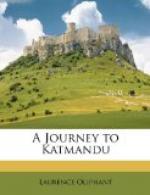The journey from Katmandu to Segowly can scarcely be accomplished in less than three days and three nights, not on account of the distance, but of the frightfully bad roads, which quite preclude the possibility of travelling faster than at the rate of two miles an hour.
There is scarcely a country in the world in which the state of the roads is so much to be lamented, since, apart from the benefit which would accrue to Nepaul itself, we too should be gainers, by having not only the valuable productions of Nepaul brought to our markets, but also those of the more distant Thibet, which are always precious from their intrinsic value, and the cost of which is at present greatly increased by reason of the expensive journey across the Nepaulese hills in addition to the transit of the Himalayas.
The Terai is at present the only part of the Nepaul dominions which is profitable from the revenue yielded by its productions. Valuable timber and turpentine, ivory and hides, are shipped down the Boori Gundak, on which river Segowly is situated, to Calcutta; still the cost of a government licence for cutting timber is so heavy as in a great measure to deter speculators from engaging in an undertaking in which so considerable an outlay is demanded, exclusive of the expenses attendant on the felling and transport of the timber. Besides the saul the Terai contains ebony, mimosa, and other useful trees.
The trade in hides is not, as I have already remarked, carried out to the extent it is capable of. But in spite of all these drawbacks, the Terai alone, of all the Nepaul dominions, can be looked upon by the British as offering a profitable field for trade and commercial speculations.
Nevertheless, the interior of Nepaul contains productions far more valuable than those of the Terai. Its mineral resources are such as would in all probability, if properly developed, render their mountainous, and in some parts barren country, one of the richest in the world. Iron, lead, copper, and zinc mines abound, and are in fact worked, but, from all I could learn, so very badly, that, even did their roads allow of the export of the metals, it is to be questioned whether, without the application of a better system, enough metal could be obtained to do more than supply the home demand.




